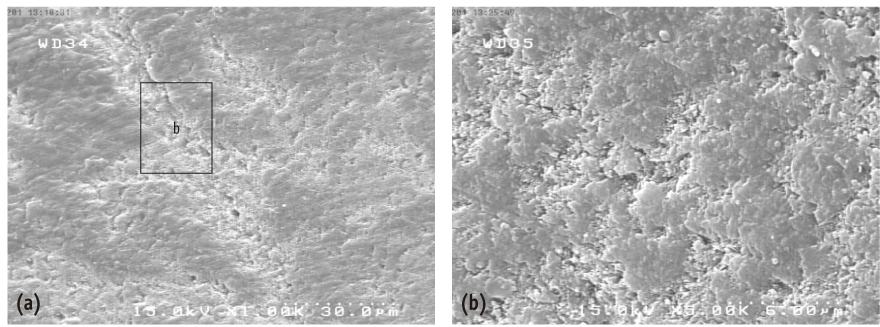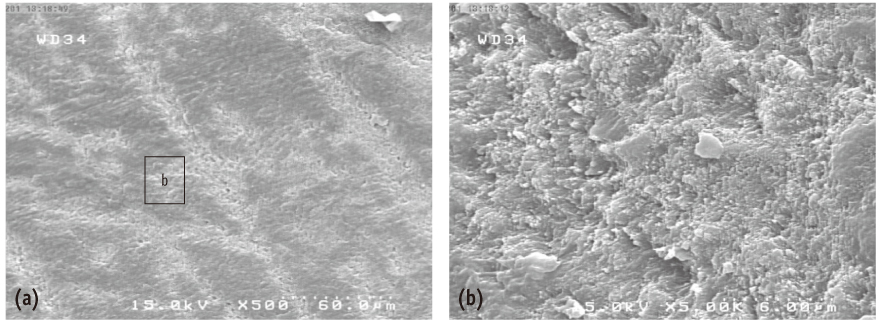Restor Dent Endod.
2013 Nov;38(4):241-247.
Effect of Epigallocatechin Gallate on shear bond strength of composite resin to bleached enamel: an in vitro study
- Affiliations
-
- 1Dental Research Center, Department of Operative Dentistry, Dental School, Hamadan University of Medical Sciences, Hamadan, Iran. Loghmansofi@umsha.ac.ir
- 2Dental Research Center, Department of Oral Medicine, Dental School, Hamadan University of Medical Sciences, Hamadan, Iran.
- 3Department of Operative Dentistry, Kordestan University of Medical Sciences, Sanandaj, Iran.
Abstract
OBJECTIVES
The aim of this study was to determine the effect of epigallocatechin gallate (EGCG) on the shear bond strength of composite resin to bleached enamel.
MATERIALS AND METHODS
Ninety enamel surfaces of maxillary incisors were randomly divided into 9 groups as follows: G1: control (no bleaching); G2: bleaching; G3: bleaching and storage for seven days; G4 - 6: bleaching and application of 600, 800 and 1,000 micromol of EGCG-containing solution for 10 minutes, respectively; G7 - 9: bleaching and application of 600, 800 and 1,000 micromol of EGCG-containing solution for 20 minutes, respectively. The specimens were bleached with 30% hydrogen peroxide gel and a composite resin cylinder was bonded on each specimen using a bonding agent. Shear bond strength of the samples were measured in MPa. Data was analyzed using the two-way ANOVA and Tukey HSD tests (alpha = 0.05).
RESULTS
The maximum and minimum mean shear bond strength values were observed in G1 and G2, respectively. Time and concentration of EGCG showed no significant effects on bond strength of the groups (p > 0.05). Multiple comparison of groups did not reveal any significant differences between the groups except for G2 and all the other groups (p < 0.05).
CONCLUSIONS
There is a significant decrease in bond strength of composite resin to enamel immediately after bleaching. A delay of one week before bonding and the use of EGCG increased bond strength of composite resin to bleached enamel.
Figure
Reference
-
1. Garcia EJ, Oldoni TL, Alencar SM, Reis A, Loguercio AD, Grande RH. Antioxidant activity by DPPH assay of potential solutions to be applied on bleached teeth. Braz Dent J. 2012; 23:22–27.
Article2. Joiner A. Tooth colour: a review of the literature. J Dent. 2004; 32:Suppl 1. 3–12.
Article3. Heymann HO. Additional Conservative Esthetic Procedure. Sturdevant's Art and Science of Operative Dentistry. 6th ed. Philadelphia: Elsevier Health Sciences;2013. Chapter 12.4. Türkün M, Kaya AD. Effect of 10% sodium ascorbate on the shear bond strength of composite resin to bleached bovine enamel. J Oral Rehabil. 2004; 31:1184–1191.
Article5. Coyle CH, Philips BJ, Morrisroe SN, Chancellor MB, Yoshimura N. Antioxidant effects of green tea and its polyphenols on bladder cells. Life Sci. 2008; 83:12–18.
Article6. Khoroushi M, Feiz A, Khodamoradi R. Fracture resistance of endodontically-treated teeth: effect of combination bleaching and an antioxidant. Oper Dent. 2010; 35:530–537.
Article7. Uysal T, Ertas H, Sagsen B, Bulut H, Er O, Ustdal A. Can intra-coronally bleached teeth be bonded safely after antioxidant treatment? Dent Mater J. 2010; 29:47–52.
Article8. Kaya AD, Türkün M. Reversal of dentin bonding to bleached teeth. Oper Dent. 2003; 28:825–829.9. Cavalli V, Reis AF, Giannini M, Ambrosano GM. The effect of elapsed time following bleaching on enamel bond strength of resin composite. Oper Dent. 2001; 26:597–602.10. Kaya AD, Türkün M, Arici M. Reversal of compromised bonding in bleached enamel using antioxidant gel. Oper Dent. 2008; 33:441–447.
Article11. Bulut H, Turkun M, Kaya AD. Effect of an antioxidizing agent on the shear bond strength of brackets bonded to bleached human enamel. Am J Orthod Dentofacial Orthop. 2006; 129:266–272.
Article12. Muraguchi K, Shigenobu S, Suzuki S, Tanaka T. Improvement of bonding to bleached bovine tooth surfaces by ascorbic acid treatment. Dent Mater J. 2007; 26:875–881.
Article13. Sasaki RT, Flório FM, Basting RT. Effect of 10% sodium ascorbate and 10% alpha-tocopherol in different formulations on the shear bond strength of enamel and dentin submitted to a home-use bleaching treatment. Oper Dent. 2009; 34:746–752.
Article14. Lambert JD, Elias RJ. The antioxidant and pro-oxidant activities of green tea polyphenols: a role in cancer prevention. Arch Biochem Biophys. 2010; 501:65–72.
Article15. Frei B, Higdon JV. Antioxidant activity of tea polyphenols in vivo: evidence from animal studies. J Nutr. 2003; 133:3275S–3284S.16. Huang CC, Wu WB, Fang JY, Chiang HS, Chen SK, Chen BH, Chen YT, Hung CF. Epicatechin-3-gallate, a green tea polyphenol is a potent agent against UVB-induced damage in HaCaT keratinocytes. Molecules. 2007; 12:1845–1858.
Article17. Kato MT, Magalhães AC, Rios D, Hannas AR, Attin T, Buzalaf MA. Protective effect of green tea on dentin erosion and abrasion. J Appl Oral Sci. 2009; 17:560–564.
Article18. Naderi NJ, Niakan M, Kharazi Fard MJ, Zardi S. Antibacterial activity of Iranian green and black tea on streptococcus mutans: an in vitro study. J Dent (Tehran). 2011; 8:55–59.19. Poorni S, Kumar RA, Shankar P, Indira R, Ramachandran S. Effect of 10% sodium ascorbate on the calcium: Phosphorus ratio of enamel bleached with 35% hydrogen peroxide: an in vitro quantitative energydispersive Xray analysis. Contemp Clin Dent. 2010; 1:223–226.20. Rotstein I, Lehr Z, Gedalia I. Effect of bleaching agents on inorganic components of human dentin and cementum. J Endod. 1992; 18:290–293.
Article21. Dabas D, Patil AC, Uppin VM. Evaluation of the effect of concentration and duration of application of sodium ascorbate hydrogel on the bond strength of composite resin to bleached enamel. J Conserv Dent. 2011; 14:356–360.
Article22. Barcellos DC, Benetti P, Fernandes VV Jr, Valera MC. Effect of carbamide peroxide bleaching gel concentration on the bond strength of dental substrates and resin composite. Oper Dent. 2010; 35:463–469.
Article23. Feiz A, Khoroushi M, Gheisarifar M. Bond strength of composite resin to bleached dentin: effect of using antioxidant versus buffering agent. J Dent (Tehran). 2011; 8:60–66.24. Roy P, George J, Srivastava S, Tyagi S, Shukla Y. Inhibitory effects of tea polyphenols by targeting cyclooxygenase-2 through regulation of nuclear factor kappa B, Akt and p53 in rat mammary tumors. Invest New Drugs. 2011; 29:225–231.
Article25. Kunt GE, Yılmaz N, Sen S, Dede DÖ. Effect of antioxidant treatment on the shear bond strength of composite resin to bleached enamel. Acta Odontol Scand. 2011; 69:287–291.
Article26. Yang CS, Maliakal P, Meng X. Inhibition of carcinogenesis by tea. Annu Rev Pharmacol Toxicol. 2002; 42:25–54.
Article27. Ho CT, Chen Q, Shi H, Zhang KQ, Rosen RT. Antioxidative effect of polyphenol extract prepared from various Chinese teas. Prev Med. 1992; 21:520–525.
Article28. Kanwar J, Taskeen M, Mohammad I, Huo C, Chan TH, Dou QP. Recent advances on tea polyphenols. Front Biosci (Elite Ed). 2012; 4:111–131.
Article29. Carnelio S, Khan SA, Rodrigues G. Definite, probable or dubious: antioxidants trilogy in clinical dentistry. Br Dent J. 2008; 204:29–32.
Article30. Young IS, Woodside JV. Antioxidants in health and disease. J Clin Pathol. 2001; 54:176–186.
Article31. Suzuki Y, Miyoshi N, Isemura M. Health-promoting effects of green tea. Proc Jpn Acad Ser B Phys Biol Sci. 2012; 88:88–101.
Article32. Shimizu M, Adachi S, Masuda M, Kozawa O, Moriwaki H. Cancer chemoprevention with green tea catechins by targeting receptor tyrosine kinases. Mol Nutr Food Res. 2011; 55:832–843.
Article33. Suganuma M, Saha A, Fujiki H. New cancer treatment strategy using combination of green tea catechins and anticancer drugs. Cancer Sci. 2011; 102:317–323.
Article34. Türkün M, Celik EU, Kaya AD, Arici M. Can the hydrogel form of sodium ascorbate be used to reverse compromised bond strength after bleaching? J Adhes Dent. 2009; 11:35–40.35. Kimyai S, Valizadeh H. Comparison of the effect of hydrogel and a solution of sodium ascorbate on dentin composite bond strength after bleaching. J Contemp Dent Pract. 2008; 9:105–112.
Article36. Dominici JT, Eleazer PD, Clark SJ, Staat RH, Scheetz JP. Disinfection/sterilization of extracted teeth for dental student use. J Dent Educ. 2001; 65:1278–1280.
Article37. Lima AF, Fonseca FM, Freitas MS, Palialol AR, Aguiar FH, Marchi GM. Effect of bleaching treatment and reduced application time of an antioxidant on bond strength to bleached enamel and subjacent dentin. J Adhes Dent. 2011; 13:537–542.38. Nour El-din AK, Miller BH, Griggs JA, Wakefield C. Immediate bonding to bleached enamel. Oper Dent. 2006; 31:106–114.
Article39. Kimyai S, Valizadeh H. The effect of hydrogel and solution of sodium ascorbate on bond strength in bleached enamel. Oper Dent. 2006; 31:496–499.
Article40. Torres G, Koga A, Borges A. The effects of anti-oxidants as neutralizers of bleaching agents on enamel bond strength. Braz J Oral Sic. 2006; 5:971–975.
- Full Text Links
- Actions
-
Cited
- CITED
-
- Close
- Share
- Similar articles
-
- Effect of pre-heating on some physical properties of composite resin
- The shear bond strength of two adhesives bonded to composite resin and glass ionomer cement restorations
- Effects Of Tooth-Whitening Agent On Enamel And Dentin: A Confocal Laser Scanning Microscopy Study
- Effect of various bleaching treatments on shear bond strength of different universal adhesives and application modes
- The effect of repeated bonding on the shear bond strength of different resin cements to enamel and dentin





